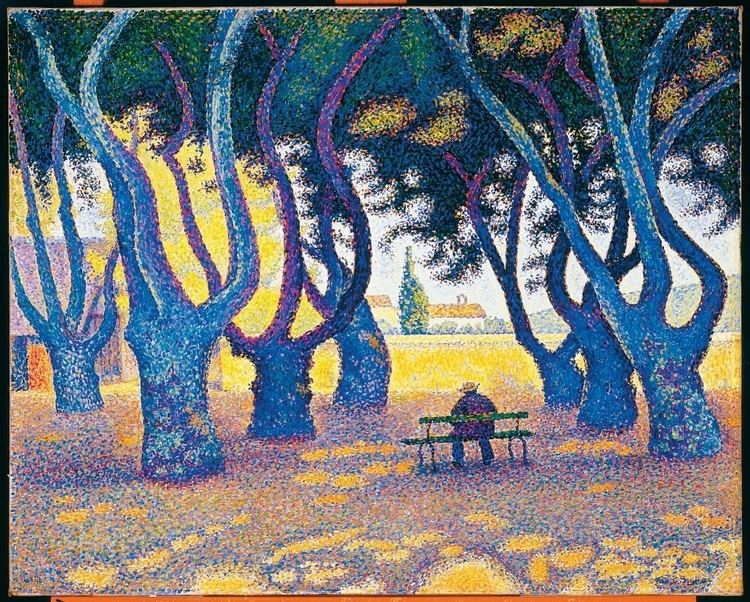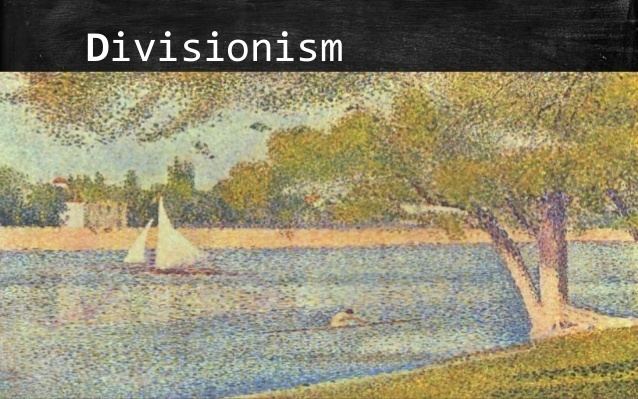Year 1884–86 | ||
 | ||
Dimensions 207.6 cm × 308 cm (81.7 in × 121.3 in) Similar A Sunday Afternoon on the Isl, The Fourth Estate, The Bellelli Family, The Blue Rider, Luxe - Calme et Volupté | ||
Neo impressionism and divisionism
Divisionism (also called chromoluminarism) was the characteristic style in Neo-Impressionist painting defined by the separation of colors into individual dots or patches which interacted optically.
Contents
- Neo impressionism and divisionism
- Theoretical foundations and development
- Paul Signac and other artists
- Color theory
- Divisionism in France and Northern Europe
- Divisionism in Italy
- Criticism and controversy
- Scientific misconceptions
- References

By requiring the viewer to combine the colors optically instead of physically mixing pigments, Divisionists believed they were achieving the maximum luminosity scientifically possible. Georges Seurat founded the style around 1884 as chromoluminarism, drawing from his understanding of the scientific theories of Michel Eugène Chevreul, Ogden Rood and Charles Blanc, among others. Divisionism developed along with another style, Pointillism, which is defined specifically by the use of dots of paint and does not necessarily focus on the separation of colors.

Theoretical foundations and development

Divisionism developed in nineteenth-century painting as artists discovered scientific theories of vision that encouraged a departure from the tenets of Impressionism, which at that point had been well-developed. The scientific theories and rules of color contrast that would guide composition for Divisionists placed the movement of Neo-Impressionism in contrast with Impressionism, which is characterized by the use of instinct and intuition. Scientists or artists whose theories of light or color had some impact on the development of Divisionism include Charles Henry, Charles Blanc, David Pierre Giottino Humbert de Superville, David Sutter, Michel Eugène Chevreul, Ogden Rood and Hermann von Helmholtz.
Paul Signac and other artists

Divisionism, along with the Neo-Impressionism movement as a whole, found its beginnings in Georges Seurat's masterpiece, A Sunday Afternoon on the Island of La Grande Jatte. Seurat had received classical training at the École des Beaux-Arts, and, as such, his initial works reflected the Barbizon style. In 1883, Seurat and some of his colleagues began exploring ways to express as much light as possible on the canvas By 1884, with the exhibition of his first major work, Bathing at Asnières, as well as croquetons of the island of La Grande Jatte, his style began taking form with an awareness of Impressionism, but it was not until he finished La Grande Jatte in 1886 that he established his theory of chromoluminarism. In fact, La Grande Jatte was not initially painted in the Divisionist style, but he reworked the painting in the winter of 1885-6, enhancing its optical properties in accordance with his interpretation of scientific theories of color and light
Color theory

Charles Blanc's Grammaire des arts du dessin introduced Seurat to the theories of color and vision that would inspire chromoluminarism. Blanc's work, drawing from the theories of Michel Eugène Chevreul and Eugène Delacroix, stated that optical mixing would produce more vibrant and pure colors than the traditional process of mixing pigments. Mixing pigments physically is a subtractive process with cyan, magenta, and yellow being the primary colors. On the other hand, if colored light is mixed together, an additive mixture results, a process in which the primary colors are red, green and blue. The optical mixture which characterized Divisionism — the process of mixing color by juxtaposing pigments — is different from either additive or subtractive mixture, although combining colors in optical mixture functions the same way as additive mixture, i.e. the primary colors are the same. In reality, Seurat's paintings did not actually achieve true optical mixing; for him, the theory was more useful for causing vibrations of color to the viewer, where contrasting colors placed near each other would intensify the relationship between the colors while preserving their singular separate identity.
In Divisionist color theory, artists interpreted the scientific literature through making light operate in one of the following contexts:
Seurat’s theories intrigued many of his contemporaries, as other artists seeking a reaction against Impressionism joined the Neo-Impressionist movement. Paul Signac, in particular, became one of the main proponents of divisionist theory, especially after Seurat’s death in 1891. In fact, Signac’s book, D’Eugène Delacroix au Néo-Impressionnisme, published in 1899, coined the term Divisionism and became widely recognized as the manifesto of Neo-Impressionism.
Divisionism in France and Northern Europe
In addition to Signac, other French artists, largely through associations in the Société des Artistes Indépendants, adopted some Divisionist techniques, including Camille and Lucien Pissarro, Albert Dubois-Pillet, Charles Angrand, Maximilien Luce, Henri-Edmond Cross and Hippolyte Petitjean. Additionally, through Paul Signac’s advocacy of Divisionism, an influence can be seen in some of the works of Vincent van Gogh, Henri Matisse, Jean Metzinger, Robert Delaunay and Pablo Picasso.
In 1907 Metzinger and Delaunay were singled out by the critic Louis Vauxcelles as Divisionists who used large, mosaic-like 'cubes' to construct small but highly symbolic compositions. Both artists had develop a new sub-style that had great significance shortly thereafter within the context of their Cubist works. Piet Mondrian, Jan Sluijters, Leo Gestel and Nico van Rijn, in the Netherlands, developed a similar mosaic-like Divisionist technique circa 1909. The Futurists later (1909–1916) would adapt the style, in part influenced by Gino Severini's Parisian experience (from 1907), into their dynamic paintings and sculpture.
Divisionism in Italy
The influence of Seurat and Signac on some Italian painters became evident in the First Triennale in 1891 in Milan. Spearheaded by Grubicy de Dragon, and codified later by Gaetano Previati in his Principi scientifici del divisionismo of 1906, a number of painter mainly in Northern Italy experimented to various degrees with these techniques.
Pellizza da Volpedo applied the technique to social (and political) subjects; in this he was joined by Morbelli and Longoni. Among Pelliza’s Divisionist works were Speranze deluse (1894) and Il sole nascente (1904). It was, however, in the subject of landscapes that divisionism found strong advocates, including Segantini, Previati, Morbelli, and Carlo Fornara. Further adherents in painting genre subjects were Plinio Nomellini, Rubaldo Merello, Giuseppe Cominetti, Angelo Barabino, Camillo Innocenti, Enrico Lionne, and Arturo Noci. Divisionism was also in important influence in the work of Futurists Gino Severini (Souvenirs de Voyage, 1911); Giacomo Balla (Arc Lamp, 1909); Carlo Carrà (Leaving the scene, 1910); and Umberto Boccioni (The City Rises, 1910).
Criticism and controversy
Divisionism quickly received both negative and positive attention from art critics, who generally either embraced or condemned the incorporation of scientific theories in the Neo-Impressionist techniques. For example, Joris-Karl Huysmans spoke negatively of Seurat’s paintings, saying “Strip his figures of the colored fleas that cover them, underneath there is nothing, no thought, no soul, nothing”. Leaders of Impressionism, such as Monet and Renoir, refused to exhibit with Seurat, and even Camille Pissarro, who initially supported Divisionism, later spoke negatively of the technique.
While most divisionists did not receive much critical approval, some critics were loyal to the movement, including notably Félix Fénéon, Arsène Alexandre and Antoine de la Rochefoucauld.
Scientific misconceptions
Although Divisionist artists strongly believed their style was founded in scientific principles, some people believe that there is evidence that Divisionists misinterpreted some basic elements of optical theory. For example, one of these misconceptions can be seen in the general belief that the Divisionist method of painting allowed for greater luminosity than previous techniques. Additive luminosity is only applicable in the case of colored light, not juxtaposed pigments; in reality, the luminosity of two pigments next to each other is just the average of their individual luminosities. Furthermore, it is not possible to create a color using optical mixture which could not also be created by physical mixture. Logical inconsistencies can also be found with the Divisionist exclusion of darker colors and their interpretation of simultaneous contrast.
